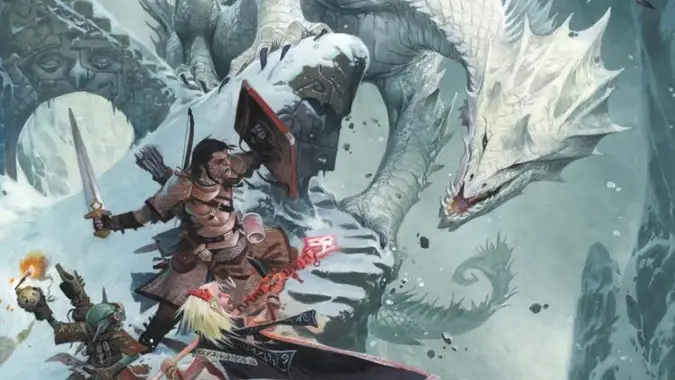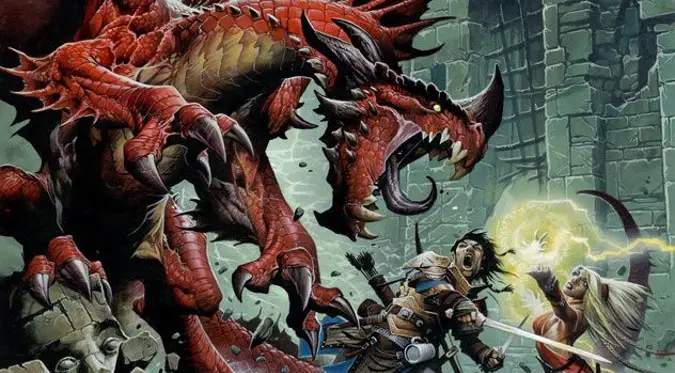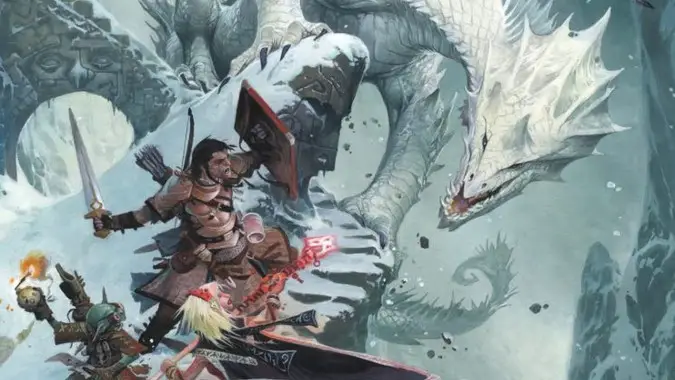Off Topic: The Pathfinder RPG shows why Open Gaming is wonderful

If you don’t know, I’ll say it now: I’m a giant nerd for role-playing games. My office is filled with D&D books going back to the 70s, RPGs from GURPS to Champions to the Chaosium Call of Cthulhu and Stormbringer series. I’m that guy who will actually go into a breakdown of the difference between original flavor D&D and AD&D and why there was seriously a time where you could decide between a version of D&D where Elves and Dwarves were character classes and another version, put out by the exact same company, where they were player races and they could choose a class or even multi-class.
I have been playing and collecting this stuff for a while, is what I’m saying.
One of my favorite versions of D&D was the 3rd Edition, put out by Wizards of the Coast after they acquired TSR, the original publishers of Dungeons and Dragons. This article isn’t a history lesson — and if you want a series of articles that are dives into the history of D&D and RPGs in general, just let me know, because I’ll happily write them — so let me just say that 3rd Edition was essentially where the D&D/AD&D distinctions were dropped, and the game reached the sweet spot for me in terms of systems and gameplay. This wasn’t hurt by the fact that the game was released with an Open Gaming License (the OGL) that meant it was essentially free to use for outside publishers. As long as you obeyed the terms of the license and pointed people towards the Player’s Handbook, you could even label your product as compatible with Dungeons and Dragons. A lot of people did, too — there were a lot of third-party products for 3rd Edition D&D.

Open Gaming leads to a new path
The 3.5 revision to the game was one of my favorites, and I spent a lot of time playing and collecting as many books as I could for it. As a result, when D&D announced it was going to a 4th Edition I was disappointed. I owned a lot of D&D 3e stuff, and a lot that was compatible with it. The 4th Edition has gotten a bad rap from some players (myself included at the time), but nowadays I look kindly on it — it was, by and large, a well-designed RPG that I think suffered because it tried too many new things for player comfort. It was a good game. It just didn’t feel like it was the same game. As a result, when the folks at Paizo announced that they were taking the 3.5 rule set available through the OGL and making a new RPG that was fully backwards compatible with it, my ears perked up. As a DM and a player, I had a lot of material that would be compatible with that system.
In a very real way, Pathfinder is the result of that boom of third-party material, and the OGL that made it possible. My copy of the original Pathfinder RPG has the OGL printed in it just before the index.
When Pathfinder came out in August of 2009, I bought it. I still have that original copy on my bookshelf. It’s been lovingly distressed by reading and rereading and use and abuse over the years. It’s not necessarily better than 4th Edition, but it was the game I wanted, and it took everything I liked about 3.5 and improved upon it. Brilliant art — all the images in this post are by Wayne Reynolds, one of the key artists for Pathfinder and I’ve been a gigantic fan of his since his work on 3rd Ed — and lavishly well-designed books that I still enjoy reading despite my failing eyes over the decade. I’ve played it for years, while also playing D&D (I’m in a 5e campaign right now, in fact), and one of the things I like about Pathfinder to this day is the granularity of the system. If there’s something I want to do on a character — a particular character idea or build — I have never once been stymied by the rules or a lack of flexibility in it. You could argue that Pathfinder has too much going on. Certainly it’s not as easy to run out of the box as 5e is — but that’s what I like about it.

Two roads, diverging
Still, it’s a ten-year-old game, and one that’s built on the bones of a game that came out nine years before it did. 3rd Edition D&D debuted in 2000. People who are playing and running D&D games right now weren’t even born yet when it was published. So to me, it’s not surprising that Paizo is finally putting out a second edition of their flagship RPG. The release of Starfinder in 2017 showed that you could update some of the Pathfinder mechanics and keep the “vibe” of the game, so to speak. I took part in the Pathfinder 2e Playtest, and frankly I love the game. I love it both for itself as a standalone experience and for how it provides a completely alternate take on where D&D could have/should have gone following 3.5 — in a way it’s a fascinating alternate-reality experiment.
Please note — I do not think Coke/Pepsi Cola Wars style rhetoric is useful or worthwhile when discussing RPG systems. For one thing, there are so many — there’s the Fate system, the Hero system, Fantasy AGE, HeroQuest, Cypher System, the Chaosium system used in the aforementioned Call of Cthulhu, and a ton of indie games with unique independent systems like Night’s Black Agents or Fading Suns, and so many more. There are more RPG’s out now than anyone could ever play in a lifetime. What I find most worthwhile about Pathfinder, and especially its upcoming Second Edition, is that it both embodies and displays the potential of open gaming — that through it, a complete alternative version of the game I’ve played for years could coexist and be its own thing. As of right now, both 5th Edition Dungeons and Dragons and the Pathfinder RPG are published under the OGL, and I think that’s magnificent.

Alternate universes, or at least alternate means to make them
Keep in mind, 2nd Edition isn’t out yet — I have the Playtest documents and errata, of course, but I don’t know how the final game is going to shape up. You can watch this live demo run by Jason Bulmahn (design director and original creator of Pathfinder) at GAMA this year. The three-modes system of Pathfinder 2e isn’t new, but it’s interesting to see it divided up in the game itself, and I like the way Critical Success and Critical Failures work in the game. If you’ve played D&D, even just 5th Edition, you’re going to recognize Pathfinder because the two games derive from the same DNA, essentially. But in many places where 5th Edition has deliberately simplified itself, Pathfinder seems to have gone for more options, and it relies much more on taking feats to customize who or what they are.
I also like how they’ve changed shields, making them more like weapons and armor at the same time. There’s a whole host of unique and interesting changes to systems here, making the game feel distinct and unique while still compatible with its brother systems 3.5 and 5e D&D. I definitely recommend Pathfinder 2nd Edition. Everything I’ve seen of the playtests makes me optimistic that this is a really solid RPG and it will be a good addition to the family of games, letting players pick a system that works right for them. And as a bonus, Paizo makes extraordinarily good Adventure Paths for its games that are not terribly hard to convert to other systems, if that’s something you could make use of.
And it’s all because of that Open Gaming License.
Please consider supporting our Patreon!
Join the Discussion
Blizzard Watch is a safe space for all readers. By leaving comments on this site you agree to follow our commenting and community guidelines.
 @MatthewWRossi
@MatthewWRossi



